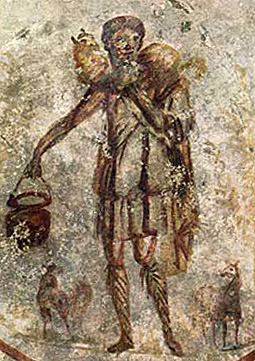Roman catacombs are a series of underground burials that span from the early second century to the fifth century (A.D).
Introduction to Catacombs of Rome
The catacombs of Rome were maintained till the 9th century when many of the relics were removed and placed within the city walls by the church. After this, the catacombs of Rome fell into oblivion until the 15th and 16th centuries.
Several prominent Roman catacombs include those of Praetextatus, San Sebastiano, San Callisto, and the Jewish Catacombs of the Villa Torlonia.
The Catacombs of Praetextatus
The Catacombs of Praetextatus were built as far back as the 2nd century. They were originally built by an aristocratic Roman family and intended for their use.
These catacombs eventually became the burial choice of many leading aristocratic and pagan Roman figures. For example, the Emperor Balbinus (A.D 238) was buried here. Afterward, in the 4th century, it became used by the Christians to bury their martyrs, such as St. Janvier, St. Felicissimus, and St. Agapitus(second half of 4th C.).
The Catacomb of Praetextatus can be accessed along the Via Appia in Rome. Upon entering the site, one will find a large cemetery with two staircases leading below ground. The subject matter of the wall paintings is highly typical of early 3rd-century Christian art.
Quite noticeable is the use of red and green framing around the center image as well as the popular motifs of the four seasons, sky, and earth located in the background. The scenes in the paintings are New Testament stories and events.
Sadly, only a few paintings still exist and can be recognized as the raising of Lazarus, the healing of the woman with an issue of blood, and Jesus with the Samaritan woman at the well.
Perhaps the most unusual image is that of Christ with the crown of thorns. It is negative and violent and strays far from the typical Christian motif of redemption and is worth noting.
The Catacombs of San Sebastiano
The Catacombs of San Sebastiano are also located on the Via Appia in Rome. The namesake of these Catacombs is a figure of legend and was said to have been killed during Emperor Diocletian’s reign (A.D. 284-302) for defecting to Christianity while he was serving as captain of the Praetorian Guard.
San Sebastiano’s crypt is located below the 13th-century church, which sits atop the Catacombs. His restored crypt is marked by a new table altar which has been built over the site of the original. Worth noting is the bust of St. Sebastian, which has been attributed to the famous artist Bernini.
Peter and Paul were believed to be buried here in the rear of the basilica. However, excavations revealed instead a tomb for another Christian Martyr, Quirinus (A.D. 5th C.) But a remarkable inscription still exists above the altar in the apsidal mausoleum, which reads ”Domus Petri” (Home of Peter).
Thirteenth-century paintings in the Catacombs of San Sebastiano are the painting of Peter and Paul, The Crucifixion, Massacre of the Innocents, and Madonna and Child.
The Catacombs of San Callisto

A third sub-city burial site located on the Via Appia is the Catacombs of San Callisto. In use during the 2nd century, these catacombs became the official catacombs of the Church of Rome. More than fifty martyrs are buried here, as well as sixteen Bishops of Rome.
These catacombs are almost 20 km long. Also, here are the crypts of the Popes, St. Cecilia, and the Crypt of the Sacraments. The most ancient part of these catacombs is represented by the fresco of the Good Shepherd (on the ceiling) and the Fish and Loaves.
The frescos here are an array of styles from the 2nd to 8th century. Take special note of the scenes of Jonah and many other Old Testament scenes. The heavy biblical themes were painted between 320 and 350 A.D.
The Jewish Catacombs of the Villa of Torlonia
The Jewish catacombs of the Villa of Torlonia were discovered in 1918 by accident. Inside are an array of 2nd and 3rd-century epitaphs (inscriptions honoring the dead) and classic symbols of Jewish religion and also Greco-Roman motifs, which include dolphins, grapevines, tridents, Menorahs, Shofars, and Ethrogs.
Unfortunately, the catacombs are closed to the public due to structure instability and toxic gas. Christian burial use in the form of Catacombs ceased in the 5th century, but the memory of the catacombs was kept alive by the cults of the martyrs, in which many traveled from far to the sanctuaries and basilicas to reverence the scared relics kept there.
How To Get To The Catacombs
- Catacombs of San Sebastiano
You can reach the Catacombs of San Sebastiano from the San Giovanni Metro Station. Once you get off here, take the bus nr 218 and get off near the Fosse Ardeatine. Walk along via Delle Sette Chiese to the catacombs entrance. - Catacombs of San Calisto
From Termini Station, hop on the bus nr. 714 and get off at San Giovanni Laterano Square. From here, you have to take the bus nr. 218 and get off at the bus stop nearby the Fosse Ardeatine. A few steps away is the entrance to the catacombs. - Jewish Catacombs of Villa Torlonia
From Termini train Station, you can take the bus nr. 90 Express and get off after 4 bus stops on Via Nomentana